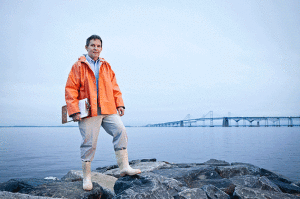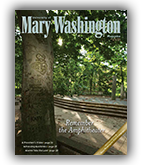When Thomas Parham ’86 came to the University of Mary Washington as an undergraduate, he was already an avid fisherman. By graduation, he’d turned that passion into a career.
Parham, 50, is director of the Maryland Department of Natural Resources Tidewater Ecosystems Assessment office. After leaving Mary Washington with a degree in biology, Parham earned a master’s degree in oceanography from Old Dominion University in 1989. “I guess the common thread is that I love to fish,” he said. “I like to figure out where the fish are going to be.”

Thomas Parham, shown here at Sandy Point State Park, is in charge of monitoring water quality
for Maryland’s portion of the Chesapeake Bay.
Photo by John Boal Photography
Today Parham manages a network of water-quality monitors around the Maryland portion of the Chesapeake Bay. The bay’s health is getting better overall, he said, thanks to mandatory state water-quality goals. “We’re starting to see improvements in the bay’s watershed,” he said, noting that earlier voluntary goals failed. “The amount of polluted runoff is decreasing, and there are more underwater grasses.”
Parham, who lives and works in Annapolis and has an 8-year-old daughter, has been in this position since 2008. He’s been working for Maryland since starting with the Department of the Environment, where he helped study water-quality issues.
Parham grew up in Minnesota and Northern Virginia. He chose Mary Washington in part to run cross-country and track, and he credits his liberal arts studies with helping him in his work today. “One of the things I’ve realized in my career,” he said, “is how great a diverse background is.”
Parham remembered his classes in economics, psychology, and immunology as exceptional. And now that he’s working on a second master’s in environmental economics, he said, “the background from Mary Washington is very helpful.”
Professor of Biology Bill Pinschmidt, who retired from Mary Washington in 1988, helped Parham connect science with his love of nature. “He was the guy who got me interested in tying it all together,” Parham said.
When he was a student, Parham did lots of fly-fishing on the Rappahannock and Rapidan rivers. Just for fun, he even kept a largemouth bass in a 33-gallon tank on campus – though he had a hard time keeping it fed.
Today Parham is dedicated to helping the public understand and care about the state of the Chesapeake Bay. He collects data and trends on the water systems’ health and translates them so people can see how what happens in the bay affects them. “When we show people a graph of nitrogen and phosphorous levels, people don’t care. What they care about is, ‘Will the water be cleaner? Are there going to be more jobs?’ ”
That’s why Parham focuses more now on how environmental issues affect the economy, he said. “Having a broad-based background from Mary Washington has really helped me do that.”
